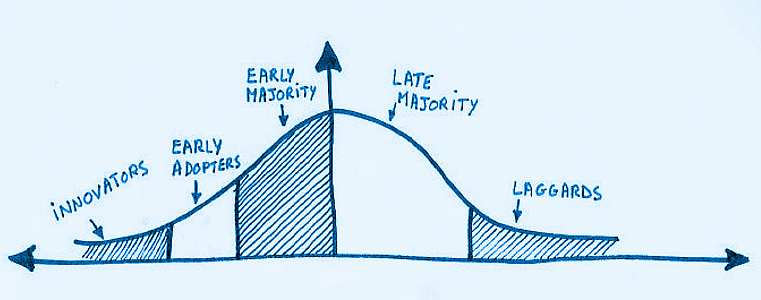Photo by Kaboompics.com from Pexels
Product adoption is the process of how a customer hears about a new product and decides to purchase it. This can be a natural process where the new product offers so many unique advantages they generate fans immediately. It can also be a prolonged process that spans decades as customers are hesitant to try a new product that requires changing old habits.
DIFFUSION OF INNOVATION
Diffusion of innovation was a study by EM Rogers in 1962. His research shines a light on to how people ultimately adopt a new idea, behavior, or product. While he performed the analysis decades ago, the key learnings in this study are still relevant today. Often they are used by marketing teams from significant corporations, Amazon included.
This research seems to be quite technical and complex, so what are the key takeaways for mobile and digital solutions? By examining a real-world example, we hope to spotlight tactics you can apply to your next digital solution project.
FIVE FACTORS
Rogers outlined five characteristics which influence a person’s decision to adopt or reject an innovation. In parallel, we add how Amazon shrewdly plays off on all five of these areas while marketing the number one e-reader in the world, the Kindle.

RELATIVE ADVANTAGE
This describes the perceived level of advancement over the previous model. For example, is the new e-Reader that much better than the earlier version? Is it better than a laptop or smartphone? Amazon made simple points but relevant points when describing its key advantage. The screen shows like paper, where it works perfectly even when reading in bright sunlight. .
COMPATIBILITY
The level of difficulty a product has for you to assimilate it into your life. Briefly, how hard is it to integrate this new thing into daily life? Reviewers praised Kindle for having the ability to hold thousands of books while easily fitting into a woman’s purse. .
COMPLEXITY
If the innovation is exceedingly complex, individuals will not likely adopt it. Consider touchscreen interface appeal over keyboard hotkeys. We’re all in a hurry, prone to laziness and the more comfortable a thing is, the happier we are to use it. Kindle went out of its way to limit functionality to simplify operations. In fact, designers made it for book worms alone, so much so that an unintended consequence was it minimized the risk of theft.
TRIALABILITY
Trialability describes how easily potential adopters can explore your innovation. Being able to touch and try the product is crucial to expediting the adoption of a change. Possible customers want to see what your innovation can do and give it a test run before committing. This is the underlying concept of trial periods and demo releases for digital goods. Potential adopters can see for themselves what life might be like once they support the product.
Currently, you can test the Kindle at Amazon’s physical retail shops and Best Buy. Before they had these opportunities, the company did marketing tours named “Read it to Believe it.” It was created to offer passers-by to examine the e-reader firsthand. Amazon would also invite its Prime members to trial offers, where they could use the Kindle for a month before committing to a purchase.
OBSERVABILITY
The extent that an innovation is visible to others. Any new product that is more visible will drive communication among friends and personal networks and in turn, create more genuine reactions. Consider the announcement from Amazon that blasted how the Kindle was its top-selling product. This told the world how readers all over the world trusted the Kindle.
NATURAL ALIGNMENT
By examining Rogers’ factors of Complexity and Trialability, you start to see why so many mobile apps struggle with getting followers. New users are confused, unconvinced or even intimidated by many of these newly launched apps. However, if more marketers become knowledgeable about diffusion theory, brands will better align with the natural process which people adopt trends.

